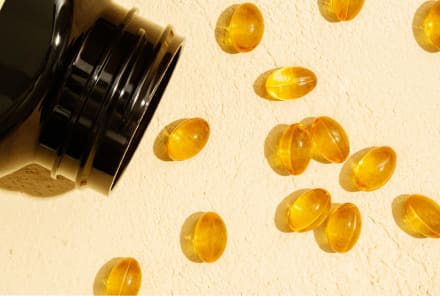Advertisement
The Hormone-Allergies Connection You Need To Know About

Have you heard of histamine? It's a natural hormone produced by mast cells, basophils, and other immune cells in several tissues in our bodies. And while many people think of it as the allergy-inducing chemical, histamine actually has important functions related to digestion, mental function, and female reproduction.
We produce histamine naturally in our bodies and we also consume it though foods like wine, cheese, and fermented vegetables. Foods like citrus, pineapple, and tomatoes don't make contain high levels of this chemical, but they do stimulate histamine release from immune cells. The body metabolizes histamine and gets rid of it through two enzymes, called HNMT and DAO.
That all sounds great, right? Well, problems with histamine can occur when there's more histamine in the body than can be broken down by those two enzymes. This is called histamine intolerance and symptoms of this can include headaches, brain fog, nasal congestion, postnasal drip, hives, rashes, anxiety, and insomnia.
The connection between histamine and estrogen.
So how is histamine connected to our hormones? For starters, if you're a woman, you're more likely to have histamine intolerance to begin with. And if your symptoms are worse at or right before ovulation, or right before your period, your hormones could definitely be to blame.
This all seems pretty unfair, but it can be explained by simple biology. As we mentioned before, mast cells store and produce histamine, but they also have estrogen and progesterone receptors1. When estrogen binds to its receptors on these cells, it causes histamine to be made and released. This means that the more estrogen you have, the more histamine you will produce. At the same time, histamine increases estrogen production. As you can imagine, this creates a vicious histamine-estrogen cycle. Estrogen also affects histamine metabolism by reducing DAO enzyme activity. In other words, estrogen makes your body produce more and excrete less histamine, contributing to histamine intolerance.
How histamine fluctuates with your monthly hormone cycle.
Interestingly, progesterone (the hormone that balances out estrogen in the body) has the opposite effect on histamine. When progesterone binds to its receptors on mast cells, it inhibits histamine release2. In addition, DAO enzyme levels fluctuate throughout the month and are highest when progesterone is at its peak3. This is all well and good if your hormones are balanced, but if you have low progesterone relative to estrogen, known as estrogen dominance, your body may be more prone to histamine intolerance.
Still not convinced about the connection between hormones and histamine? Histamine-intolerant women tend to experience more headaches at ovulation or right before their periods (times of the month when estrogen is elevated4), histamine also increases contractions of smooth muscle cells, and histamine-intolerant women tend to have more menstrual cramping, possibly due to histamine-induced contractions4 in the uterus.
How to balance your hormones for healthier histamine levels.
The good new is that reducing your estrogen load can help you reduce histamine intolerance. You can start by reducing outside sources of estrogen from phytoestrogens, such as soy and flaxseed, and birth control pills and hormone replacement therapies. Some environmental toxins can also mimic estrogen, leading to increased allergic reactions5, so it's a good idea to reduce your exposure to BPA, phthalates, parabens, and many others common in skin care products, pesticides, plastics, food additives, and industrial products. Eating cruciferous vegetables like broccoli, cauliflower, cabbage, and Brussels sprouts on daily basis can also help break down estrogen in your body to reduce your estrogen load.
Reducing stress can also help balance your hormones for healthier histamine levels. This is because stress can lower progesterone levels and allow estrogen and histamine to dominate. If you have hormone or histamine issues, mindfulness-based stress reduction techniques like yoga and meditation are important to incorporate into your routine.
Finally, let's not forget about the role of the gut in getting rid of both estrogen and histamine. Certain types of bad gut bacteria interfere with estrogen detoxification, causing more of it to circulate back into the body and increase estrogen load6. To combat this, make sure you're getting plenty of fiber in your diet to feed beneficial bacteria and keep things moving along.
If you follow these steps but continue to experience symptoms of histamine intolerance and estrogen dominance, consult with a functional medicine practitioner who can run more labs and provide an individualized food and nutrient plan. While you may be tempted to experiment with topical progesterone and botanicals that balance hormones, it's wise to not mess with them on your own and have your practitioner test and target your own specific imbalances.
Watch Next
Enjoy some of our favorite clips from classes
Enjoy some of our favorite clips from classes
What Is Meditation?
Mindfulness/Spirituality | Light Watkins
Box Breathing
Mindfulness/Spirituality | Gwen Dittmar
What Breathwork Can Address
Mindfulness/Spirituality | Gwen Dittmar
The 8 Limbs of Yoga - What is Asana?
Yoga | Caley Alyssa
Two Standing Postures to Open Up Tight Hips
Yoga | Caley Alyssa
How Plants Can Optimize Athletic Performance
Nutrition | Rich Roll
What to Eat Before a Workout
Nutrition | Rich Roll
How Ayurveda Helps Us Navigate Modern Life
Nutrition | Sahara Rose
Messages About Love & Relationships
Love & Relationships | Esther Perel
Love Languages
Love & Relationships | Esther Perel

















